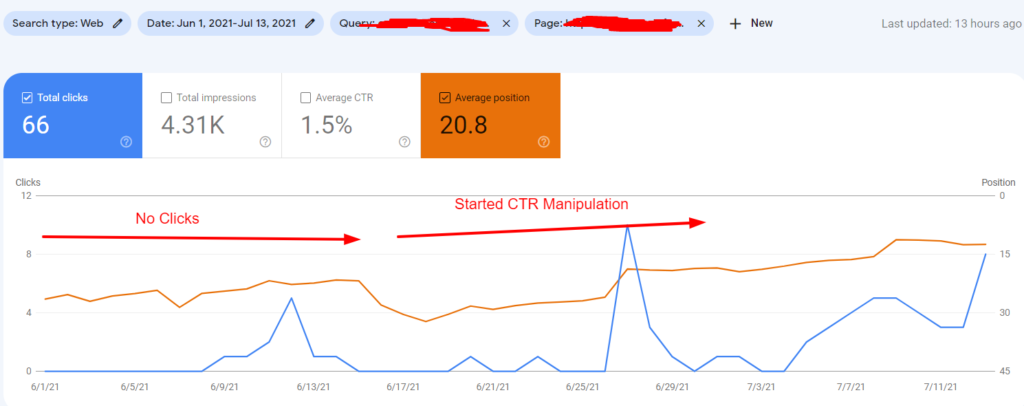CTR Control: A Game Changer for Digital Projects
The surge of CTR adjustment has actually unquestionably transformed digital advertising and marketing strategies, giving marketing professionals with devices to boost interaction and drive traffic efficiently. Methods such as A/B testing and individualized web content have actually proven to generate considerable enhancements in click-through prices. As brand names progressively leverage these methods, the moral ramifications of such techniques call for examination. Balancing the quest of optimized metrics with the requirement for genuine audience connections positions a critical obstacle for marketing experts today. What implications might this stabilizing act hold for the future of digital campaigns?
Understanding CTR Adjustment
Although click-through price (CTR) adjustment might appear like a simple technique in digital marketing, it incorporates a range of methods targeted at artificially pumping up involvement metrics. This control can take numerous types, consisting of making use of click farms, crawlers, or misleading ad placements that misinform consumers into clicking. These approaches can compromise the honesty of efficiency information, making it testing for marketing professionals to assess the real efficiency of their projects.
Additionally, CTR adjustment elevates ethical worries, as it threatens the openness of digital marketing. The reliance on filled with air metrics can bring about misguided advertising and marketing choices, skewing source allowance and campaign techniques. Companies may invest heavily in networks and tactics that appear effective yet do not produce actual interaction or conversions.

Advantages of Click-Through Price Optimization
Optimizing click-through rate (CTR) is necessary for boosting the efficiency of digital marketing projects. A higher CTR indicates that a bigger percentage of customers are involving with the web content, which can lead to boosted internet site traffic and much better conversion rates. By improving CTR, brand names can successfully allot their advertising and marketing sources to initiatives that generate the greatest returns.
Among the main advantages of CTR optimization is the potential for improved advertisement positioning and reduced expenses - CTR Manipulation. Systems like Google Ads compensate higher CTRs with far better ad positioning and minimized cost-per-click (CPC), allowing marketing professionals to stretch their budget plans further. Additionally, a well-optimized CTR can improve brand visibility, as greater interaction rates usually associate with increased natural reach

Methods for Efficient CTR Manipulation
To effectively manipulate click-through rates (CTR), marketers can use a range of critical methods that boost customer engagement and drive website traffic. One essential technique is maximizing ad copy to develop engaging and action-oriented language. CTR Manipulation. Using solid call-to-action (CTA) phrases motivates customers to take prompt action, boosting the probability of clicks
An additional efficient method is A/B screening, which permits online marketers to compare various advertisement variants. By methodically evaluating performance metrics, they can identify which aspects resonate best with the target market, therefore refining their strategies for optimal influence. Furthermore, leveraging aesthetically enticing graphics and succinct messaging can capture interest quickly, making it extra likely that customers will involve.

Lastly, optimizing touchdown web pages to make certain a seamless customer experience can reduce bounce prices and motivate additional interaction, eventually fostering greater CTR. By integrating these strategies, marketing experts can efficiently manipulate CTR to attain their project objectives.
Determining Success in Digital Campaigns
Measuring success in electronic projects requires a clear understanding of crucial performance indications (KPIs) that align with project purposes. KPIs offer as quantifiable metrics that aid examine the effectiveness of numerous methods used throughout the project. Common KPIs consist of click-through prices (CTR), conversion prices, price per purchase (CPA), and return on financial investment (ROI)
To successfully measure success, it is critical to establish certain, quantifiable objectives at the start of the campaign. As an example, if the primary objective is to enhance brand understanding, metrics such as impressions and interaction prices may be prioritized. On the other hand, campaigns concentrated on straight sales would take advantage of an extra in-depth evaluation of conversion rates and income produced.
Normal evaluation of these KPIs makes it possible for marketing professionals to make data-driven choices, optimizing their techniques in real-time. Using logical devices can assist in tracking efficiency and recognizing trends, permitting quick adjustments to enhance campaign outcomes. Ultimately, a comprehensive technique to gauging success not just highlights locations for improvement but likewise reinforces the total effectiveness of digital advertising efforts, driving sustained growth and interaction in the long term.
Future Fads in Digital Marketing
Anticipating the future of digital advertising and marketing discloses a landscape formed by quick technical improvements and altering customer actions. As synthetic knowledge and artificial intelligence continue to develop, marketing experts will increasingly leverage these innovations to customize campaigns at an unprecedented range. Predictive analytics will certainly make it these details possible for brand names to anticipate customer needs, enhancing ad positionings and material distribution in real time.
Moreover, the increase of voice search and smart tools is changing just how consumers connect with digital web content. Marketing professionals will certainly need to adjust their strategies to make certain visibility across multiple platforms, including voice-activated aides. This shift requires a concentrate on conversational advertising and marketing, emphasizing engagement via discussion as opposed to conventional marketing tactics.
Furthermore, personal privacy issues are triggering changes in data collection practices. Openness and moral data use will certainly end up being critical, driving brands to foster trust fund and commitment among customers. The recurring development of social media sites platforms will certainly likewise influence marketing techniques, with an enhanced emphasis on credibility and user-generated content.
Verdict
In recap, CTR control stands for a significant improvement in digital advertising and marketing methods, supplying prompt benefits with improved involvement metrics. The continuous development of electronic advertising will certainly depend on this fragile interaction, forming the future landscape of brand-consumer interactions.